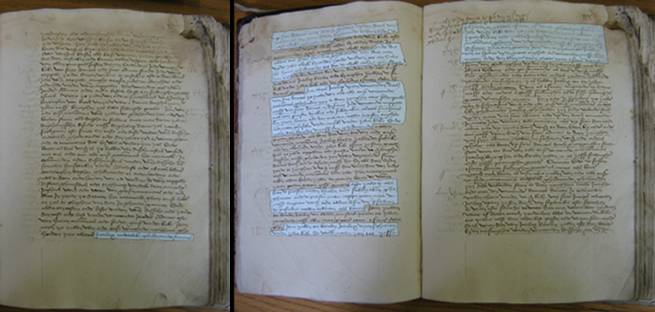Click here for a transcription of the Flemish text highlighted and translated below.
This legal document, drawn up in the spring of 1487, enabled musicologist Reinhard Strohm, almost five hundred years later, to identify the occasion for which ObrechtJacob Obrecht was a South Netherlandish composer known mainly for his substantial output of Mass Ordinary settings in the late 15th century, as well as for his motets and songs… composed his Missa de Sancto Donatiano. It is the foundation charter that establishes annual memorial service for Donaes de MoorDonaes de Moor belonged to the upper eschelon of the merchant class in Bruges… through an endowment given to the Sint JacobskerkIn Donaes de Moor’s and Adriane de Vos’s time, the Sint-Jacobskerk, dedicated to St. James the Apostle, was the most affluent of the parish churches in Bruges… by his widow Adriane de Vos. The original document – too large to photograph! – is Bruges, Rijksarchief, Inv. nr. 88 (Archief Sint-Jacobskerk Brugge), nr. [970] = regest 600 = charter 447; shown here is an exact copy preserved in the register of the Sint Jacobskerk’s foundation acts under the shelfmark Bruges, Rijksarchief, Inv. nr. 88 (Archief Sint-Jacobskerk Brugge), nr. 888. Still another copy, dated 14 March 1487, is found in a charter of the guild of the furriers, which was responsible for carrying out the service provided for by the foundation (Bruges, Stadsarchief, nr. 345, liasse 45).
Precious details concerning De Moor’s memorial Mass emerge within this charter, imparting a vivid impression of the ceremony that began with bell-ringing on the eve of the feast day. The excerpts most relevant to the occasion are noted on the photograph above, and translated below:
Why, when, where, who – the basic contextual information that has disappeared for almost all music of the period – is here spelled out in vivid detail. We learn to our surprise, for example, that the tower bells rang throughout the Mass ceremony; the charter describes a progression from ‘ringing’ to ‘chiming’ (luden to beyaerden), the latter term denoting a special bell-ringing technique that involved rhythmically playing a swinging-bell or -bells, either indirectly by rope pulls or directly with hammers or clappers. Such pealing of bells throughout memorial Masses was in fact customary in Bruges; the change to a more animated peal after a half hour suggests a connection to the progress of the ritual underway within the church, possibly signaling the transition to the eucharistic phase of the liturgy and the impending Elevation.
Select Bibliography:
Strohm, Reinhard. Music in Late Medieval Bruges. Rev. ed. Oxford: Clarendon Press, 1990. See in particular pp. 146-47.
Bloxam, M. Jennifer. “Text and Context: Obrecht’s Missa de Sancto Donatiano in its Social and Ritual Landscape.” Journal of the Alamire Foundation 3 (2011): 11-36. See in particular pp. 12-16.
Lehr, André, Wim Truyen, and Gilbert Huybens. The Art of the Carillon in the Low Countries. Tielt, Belgium: 1991. See in particular pp. 90-94.

